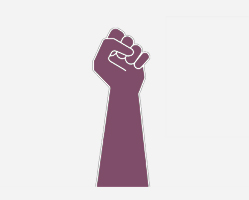1 Explore Communication
Emilda Thavaratnam
Communication is the process of transferring facts, opinions, ideas, and values from one person to another.
What You’ll Learn:
- How we communicate
- Where we communicate
- How to communicate mindfully
As social beings, we communicate all the time in a variety of settings. As you watch this video, think about the different types of communications presented and their contexts.
Watch this video for an introduction to how communication works. The three models of communication demonstrate the complexity of the process of communication.
This video provides 10 interesting facts about communication. It is created by National Geographic, a television channel that shows documentaries about nature, science, culture, and history.
Communication: Forms and Settings
Intrapersonal Communication
Intrapersonal communication is the conversations we have with ourselves when reflecting on our experiences. When we talk to ourselves, we use an internal voice that is influenced by our native language, life experiences, and cultural values.

Reflect: Think about the last time you had an interview.
- Did you have an internal conversation with yourself once it was over?
You may have said: “I did really well!” or “That was horrible. You should have practised more!”
Did you notice the difference in narration in the examples above?
When people reflect on their experiences, they tend to use first-person intrapersonal communication .“I did really well!” is an example of this.
Second-person pronouns are used when people feel the need to self-regulate or overcome difficult situations perhaps (Zell, Warriner, & Albarracín, 2012) “That was horrible. You should have practised more!” is an example of using second-person narration to overcome a difficult situation—in this case, an interview that may not have gone well.
Interpersonal Communication
Interpersonal communication involves two or more people. This type of communication can range from being formal to informal depending on the topic of conversation and the relationship we have with the person we’re speaking to.
The following chart describes the differences in structure, style, and tone between formal, semi-formal, and informal written communication. This can also be applied to other means of communication.
| FORMAL LANGUAGE | SEMI-FORMAL LANGUAGE | INFORMAL LANGUAGE | |
|---|---|---|---|
| Structure (sentences and paragraphs) | Complete sentences; sentence variety (simple, compound, complex); fully developed and properly punctuated paragraphs | Complete sentences of varying length and style (simple, compound, complex) | Generally shorter sentences and paragraphs; sentence fragments are acceptable |
| Vocabulary and Style | Specialized rhetoric/jargon; void of contractions and colloquialisms; third-person narration | A balance of everyday language as well as some subject-specific terms; can use first-, second-, or third-person narration | Colloquialisms, slang, textese, contractions are acceptable; uses first- and second-person narration |
| Tone | Direct approach; impersonal; instructional | Varies to suit purpose and audience; serious or casual | Conversational and casual |
| Examples of Use | Scientific journals, legal documents, academic writing, government documents | Newspapers, magazines, op-eds, business memos | Fiction, commercials, newspaper, personal notes, text messages, social media posts |
Reflect: Think about the last difficult conversation you had.
- Who did you talk to?
- What was the conversation about?
- What type of words did you use? Was your tone formal? Informal?
- What was your body language like?
Group Communication
Group communication occurs between a small number of people who may share similar goals.
Here are two examples of college students expressing their frustration during a group meeting.
Example 1:
“I think we need to be more diligent and organized with the way we conduct our meetings. No one has completed their part, and our project is due next week. I am a little disappointed because I worked on my part all last week, thinking we were going to rehearse today.”
Example 2:
“This sucks … and I ain’t down for this. Y’all are useless and wasting my time.”
Reflect: Think about the last time you had a conflict with a group member.
- What was the conflict about?
- What did you do to resolve the conflict?
- Did you express yourself in a clear, collegial, professional manner?
Learn more about respectful group communication here.
Public Communication
Public communication usually involves one person speaking to a larger group of people. Factors such as audience, venue, and purpose can change the delivery of this type of communication. Public communication is an integral aspect of our lives, as we do this in academic, professional, and civic settings (as will be discussed later).
Did You Know?
The first two seconds of communication are essential in creating an impression—positive or negative (Rothfield, 2009). This is why it is important to consider what you are going to say before you actually say it.
Activists often engage in public communication to advocate for social, political, economic, or environmental changes. In this video, Tamika Mallory, an American activist, speaks about the Black Lives Matter movement in a news interview. Pay close attention to her vocabulary, tone, pace, and facial expressions. How are these appropriate to her topic and this setting?

Black Lives Matter is an international organization and movement fighting anti-black racism. You can click here to learn more about the Canadian Chapter: https://blacklivesmatter.com/
Other examples of public communication include: managers explaining benefits to a group of employees; principals and deans speaking at convocations; and religious leaders speaking at places of worship.
Reflect: Think about the last time you had to give a public communication.
- What was your purpose?
- Who was your audience?
- What techniques did you use to engage your audience?
- What did you do to prepare?
Mass Communication
Public communication becomes mass communication when information is given to the audience through print or electronic media. Some examples include television, blogs, social media, radio, podcasts, and books. Requiring technology to transmit the message is what distinguishes this type of communication from others. Unlike in the case of interpersonal, group, and public communication, in mass communication, there isn’t immediate conversation or feedback (“Introduction to Communication Studies,” 2012).
Leaders of countries often have mass communication addresses. In this video, Prime Minister Justin Trudeau uses his platform to reassure Canadians that even amidst a crisis, we will persevere. Pay attention to his tone, use of words, body language, and facial expressions. How are these appropriate to his topic and this setting?
Reflect: What was the last big news story you consumed?
- How did you consume this story (social media, TV, magazines)?
- Was there a speaker? Were they engaging?
- What aspects of the story and its presentation did you enjoy?
Communication Settings

Where we communicate affects how we communicate. Communication settings influence the way we use tone, words, body language, and facial expressions. In this section, we will explore how we communicate in academic, professional, personal, and civic settings.
Academic
An academic setting is an educational environment—such as a college classroom—where people impart and exchange knowledge and experiences. You may communicate with professors, classmates, and administrators in academic settings.
Now look at these two ways of asking for an extension in an academic setting. Pay attention to the address, tone, and language used.
EXAMPLE 1:
Hi Sir,
May I request an extension for my research essay? I have a family emergency. I have a doctor’s note for you if you need it.
Many thanks,
Student A
EXAMPLE 2:
Hi Mark,
Do you remember when I told you my dad was sick? Well his illness has come back, and I’ve been at the hospital for the last two weeks. I wasn’t able to finish my research essay. My family and I are going through a really hard time right now. Is there any way you can give me an extension? I can get a note from his doctor if you need it.
Take care,
Student B
In example 1, the address, tone, and language are formal and brief. Some reasons for this may be:
- The student wants privacy.
- The student does not know the instructor well.
- Situational circumstances may have affected the email, e.g. the student may have written it in a rush while at the hospital.
In example 2, the address, tone, and language are less formal and more detailed. Some reasons for this may be:
- The student knows the instructor well.
- The student feels comfortable disclosing their family situation to others.
- Situational circumstances allowed them to spend more time writing.
In both examples, the student is professional and explains the situation.
Communication in academic settings can vary in tone depending on the relationship you have with the receiver.
See the “Develop Voice” section for more
Reflect: Think about the last time you had an academic conversation.
- What was your purpose? Who was your audience?
- Do you feel you delivered your message effectively?
Professional/Workplace
In professional or workplace settings, communication ranges from semi-formal to formal depending on the relationship between the individuals. For example, you may use more formal language and tone when speaking to your employer or conducting a meeting than when speaking to colleagues during lunch.

When communicating in professional settings:
| DO | DON’T |
|---|---|
| Be clear and direct | Be vague |
| Pay attention | Look at your phone |
| Be respectful | Interrupt |
| Think through your ideas before responding | Give quick, spur of the moment responses, especially when angry |
Be familiar with the policies and code of conduct at your place of employment. It is important to follow these in private and public—this means on social media platforms as well.
People is an American lifestyle and celebrity magazine. In this article, author Lydia Price gives examples of employees who were fired because of social media posts. Pay attention to the language, tone, and details in these tweets. Why might these posts have been considered inappropriate?
https://people.com/celebrity/employees-who-were-fired-because-of-social-media-posts/
Reflect: Think about the last time you had to communicate with someone on the job.
- What was your purpose?
- Who was your audience?
- Do you feel you had a professional exchange?
Personal
In personal settings—such as in our homes or over our phones—we communicate informally with family members, co-workers, or friends. Generally, this communication is not published or made public, so we are free to express ourselves as we wish.
In these two examples of personal communication, someone is informing another person they’re on their way.

Example 1:
“Hey, mom, where are you? I’m on my way.”
Example 2:
“S’up, where you at? OMW”
In example 1, this message is delivered in plain language. Example 2 includes textese. Textese may not be appropriate for all audiences. Your parents or grandparents may not be familiar with LOL, OMW, etc., and find your message confusing.
Even in personal settings, it is important to consider your audience when crafting your communication.
Here are some other common communication mistakes that people make.
Reflect: Think about the last time you had a personal conversation.
- Who did you talk to?
- What did you say?
- Did you feel confident about the way your message was received?
Civic
Civic settings are places where we engage in political processes or advocate for positive change for our communities, particular groups, or the public at large. Civic communication can take many forms: town halls, protests, meetings, phone calls, voting.
In this example of civic communication, Swedish activist Greta Thunberg speaks out about the importance of protecting our environment.
Exercise your right and stand up for what you believe by attending a town hall, joining a protest, or simply speaking out. Let your voice be heard respectfully.
Reflect: Think about the last time you participated in civic communication.
- Where was it?
- Who did you talk to?
- What was the message?
- Did you feel you were making a positive difference?
Advocacy means speaking up about how you can make the world a better place.
Choose one type of communication and match it with the setting for each scenario.
ANSWER A: You are the manager, and an employee has complained about verbal harassment from another employee.
Professional: This incident took place in the workplace. The manager may use professional tones to display empathy to the employee who was harassed and to display leadership in addressing a serious issue while following and respecting company policies.
ANSWER B: As a news reporter, you are going live to report on a recent COVID-19 outbreak in Toronto.
Professional: News reporters use professional tones in communicating their message.
ANSWER C: You are making a presentation to your classmates in your college communications course.
Academic: The setting is academic as it takes place at school.
We communicate all the time. It is important to be mindful and tailor your communication based your audience, purpose, and setting.
Click the link below for effective public speaking competencies
https://courses.lumenlearning.com/atdcoursereview-speechcomm-1/chapter/speaking-competencies/
References
See Explore Communication References
The background situation or larger ground within which something is situated.
The method by which a story is told.
The “I” point of view (as opposed to second person, “you,” or third person, “she/ he/ it”).
Collaborative and cooperative in spirit.
People who champion and fight for a cause, typically those engaged in fighting for justice and equity.
Speeches, or one-to-many public communications.
The language that characterizes texting, such as use of acronyms, short forms, sentence fragments, and so on.


Example 1 is specific and collegial, and expresses the reason for the student’s frustration. Example 2 is vague, not collegial, and does not address the specific reason for frustration. Academic pressures can make group work challenging. In positive group communication, it is important to be clear, open-minded, calm, and, above all, respectful.